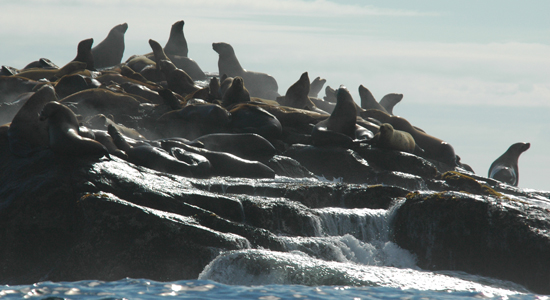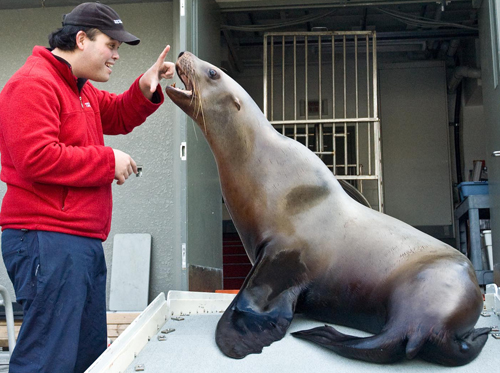
The Fasts of Life
Unappealing as it may be to most humans, fasting is a fact of life for Steller sea lions. Females endure long periods without food while nursing, and males fast while defending breeding territory. Even pups and juvenile sea lions must overcome hunger while waiting for their mothers to return from feeding at sea.
Researchers have long been aware of the Steller’s propensity to fast, but have not known what happens to the animals’ physiology during that time. Three possibilities are that they obtain energy from stored lipids, stored proteins or some combination of the two. Studies of other animals that frequently fast such as bears and penguins have shown they use their lipid stores for energy rather than their protein stores to survive fasting. Whether or not Steller sea lions employ a similar mechanism to survive fasting is unknown.
A team of biologists recently tackled this question in a unique way. Rather than measure how much protein and lipid each animal had before and after fasting, the researchers focused on taking blood samples to measure the concentration of blood metabolites. Blood metabolites are by-products of metabolic (or chemical) processes that reflect changes in the types of reserves (lipids and proteins) an animal uses to meet its energy requirements.
The researchers studied both juvenile and subadult Steller sea lions, hoping to determine not only how well blood metabolites indicate fasting and nutritional status, but also whether the Stellers’ ability to fast changes seasonally and with age. The research team comprised Lorrie Rea of the Alaska Department of Fish and Game, Michelle Berman-Kowalewski of the University of Central Florida, and David Rosen and Andrew Trites of the University of British Columbia. Their results were published in Physiological and Biochemical Zoology.

Five-star Fasters
The researchers experimentally fasted nine Steller sea lions aged 2 to 6 years old during both their breeding and non-breeding seasons. Each of the animals was fasted for one to two weeks based on predictions made from observations of sea lions in the wild about how long their subjects could maintain homeostasis (a state of internal equilibrium) while fasting.
 The sea lions proved themselves to be accomplished fasters; not one showed signs of dehydration or irreversible biochemical effects of fasting. The researchers did, however, observe significant differences between the fasting abilities of the different age groups. The subadult Stellers relied on the lipid reserves and conserved their protein stores during the breeding season, which is a time of year when they would naturally experience fasting in the wild. However, the subadult sea lions were less able to protect their protein stores during the non-breeding season when they would not normally experience food shortages. In contrast, the juvenile sea lions appeared to be better adapted to surviving a fast during the non-breeding season than during the breeding season.
The sea lions proved themselves to be accomplished fasters; not one showed signs of dehydration or irreversible biochemical effects of fasting. The researchers did, however, observe significant differences between the fasting abilities of the different age groups. The subadult Stellers relied on the lipid reserves and conserved their protein stores during the breeding season, which is a time of year when they would naturally experience fasting in the wild. However, the subadult sea lions were less able to protect their protein stores during the non-breeding season when they would not normally experience food shortages. In contrast, the juvenile sea lions appeared to be better adapted to surviving a fast during the non-breeding season than during the breeding season.
Fast Facts
The research team concurred that while metabolite concentrations in blood samples cannot accurately predict exactly how long an animal has been fasting, they can help determine whether a sea lion has been without food for longer that usual. They also found that the ability of sea lions to spare protein by relying more on catabolizing lipids during fasting seems to be determined by the proportion of body fat that an animal has prior to fasting. This is one of the most important discoveries because it also explains the seasonal difference between the different age classes of sea lions. Such findings ultimately help the researchers to identify animals and populations that are nutritionally stressed.
August 20, 2009
 PUBLICATIONS
PUBLICATIONS
|

|

 |
||||||||||||
